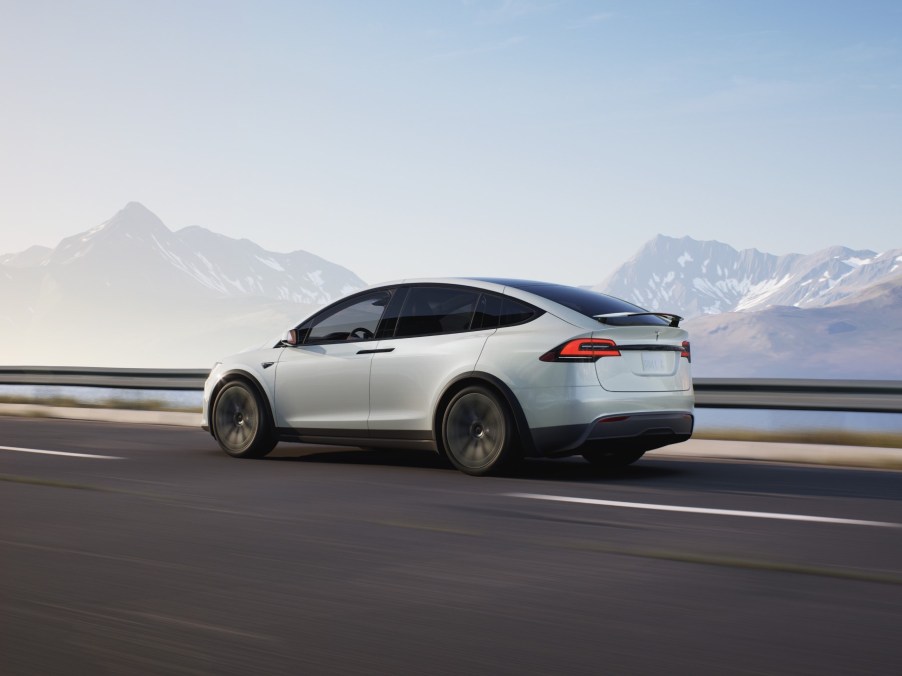
3 Reasons the Tesla Model X Isn’t the Best Electric SUV for Off-Roading
Tesla’s flagship electric SUV has earned a prestigious reputation for its speed and refinement. But if you’re looking for an EV that can go off-road, it’s best to look at something other than the Tesla Model X.
The Tesla Model X is not an electric SUV for off-road use

The 2023 Tesla Model X may be an SUV by name, but it’s better suited to city streets than rugged trails.
Over the last couple of years, several off-road-ready EVs have hit the market. From the Rivian R1S to the GMC Hummer EV, these electric SUVs blend advanced battery-electric technology with robust all-terrain performance. But that doesn’t mean they’re all good for off-roading.
It may have been one of the first mainstream electric SUVs, but the Tesla Model X isn’t close to the best one for off-road use.
Ground clearance limitations
The Tesla Model X only offers 8.9 inches of ground clearance. That’s not bad – but it falls well short of other electric SUVs.
If you want to go off-road, you need ground clearance. Clearing obstacles and having space for precise maneuvers will get you a long way down the trail. It’s a prerequisite for any serious off-road vehicle.
The Model X doesn’t have terrible ground clearance. While its minimum ride height is just over 5 inches, its air suspension can rise to 8.9 inches when needed, according to Edmunds. It’s enough for clearing potholes and snow – but there are electric SUVs that fare much better. For example, the Rivian R1S and R1T air suspension system allows up to 14.9 inches of ground clearance.
Tesla Model X doesn’t have off-road tires
Tesla offers the Model X with standard street tires rather than all-terrain or off-road tires.
The Model X’s street performance identity shows through with its shoes. Large wheels with low-profile street tires clearly aim for pavement grip and handling. These road tires would likely struggle to find traction on dirt, rocks, or mud. Plus, low-profile tires are at higher risk of rupturing on sharp stones.
According to Edmunds, the Model X does come with standard all-wheel drive. That certainly helps its case as an off-road vehicle. However, it doesn’t do much good on the trail if there isn’t proper rubber to put the power down.
Other electric SUVs like the GMC Hummer EV come standard with all-terrain tires.
You’ve got to be yoking

The Tesla yoke steering system in the Model X would likely be a pain while off-roading.
Tesla grabbed headlines when it introduced the yoke steering-control system on its Model S and Model X. While the steering yoke looks interesting, it’s not ideal for off-road use. The last thing you want to do while delicately maneuvering obstacles is to find yourself grasping air instead of confidently holding a steering wheel.
Fortunately, Tesla does offer a conventional steering wheel as an option for the Model X.
Should you take an electric SUV off-road?
While electric SUVs are starting to offer serious off-road capability, owners should still give a second thought before taking on more rugged and remote trails.
Off-road-oriented EVs are cropping up quickly, with automakers eager to simultaneously capitalize on two red-hot trends. While the Model X may not be a true off-roader, other nameplates are explicitly designed for all-terrain use. But that doesn’t mean they’re ready for the toughest challenges.
Unfortunately, off-road EVs are still limited by one variable: range.
It’s easy to strap a few gas cans onto a traditional off-road rig to help extend range. EVs don’t have that luxury. EV chargers aren’t as available in rural areas near off-road trails, let alone on the courses themselves. Get too far out into the sticks, and you might run out of range before returning to civilization. You could run a generator to get a charge – but that’s a long, tedious process.
EVs are more off-road capable than ever. But drivers might want to stick to trails closer to town until charging infrastructure improves, or mobile charging becomes more advanced.


